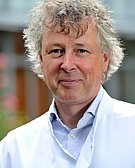B(e) NAMSE
Better outpatient care for children and young people with rare diseases
Project overview
When the exception becomes the rule: In Germany, around 4 million people are affected by a rare disease. Although the proportion of children and adolescents in this group is steadily increasing, the care situation for young people is often inadequate.
The new form of care "B(e) NAMSE - Telemedicine-supported, interdisciplinary, multi-professional and cross-age care for young people with rare diseases through NAMSE-B centre clusters" is to be developed under the leadership of Prof Dr Boris Zernikow (Head of Paediatric Palliative Medicine and German Paediatric Pain Medicine, Vestische Kinder- und Jugendklinik Datteln - Witten/Herdecke University) and Prof. Corinna Grasemann (Head of the Centre for Rare Diseases Ruhr - CeSER, University Clinic for Paediatrics and Adolescent Medicine at the Catholic Hospital Bochum - Ruhr University Bochum) to improve the care situation for young people with rare diseases. Care providers, health insurance companies and researchers work closely together in B(e) NAMSE to enable optimally structured, reliable and sustainable outpatient treatment.
Further information
- Duration: 2025 - 2028
- Funding: The Innovation Fund of the Joint Federal Committee is funding the project with around 9 million euros over 3.5 years.
- Responsible: Chair of Paediatric Pain Therapy and Paediatric Palliative Medicine
- Consortium partners: Allianz Chronischer Seltener Erkrankungen (ACHSE) e. V., AOK Bayern - Die Gesundheitskasse, AOK PLUS - Die Gesundheitskasse für Sachsen und Thüringen, BARMER, Johann Wolfgang Goethe-Universität Frankfurt, Katholisches Klinikum Bochum gGmbH, PedScience Vestische Forschungs-gGmbH, Techniker Krankenkasse, Technische Universität Dresden - Medizinische Fakultät Carl Gustav Carus, Universitätsklinikum Augsburg, Universitätsklinikum Hamburg-Eppendorf, Universitätsklinikum Würzburg
- Further information can be found in the news.
Detailed project description
Around 4 million people in Germany suffer from a rare disease. "Rare" means that no more than five in 10,000 people are affected by the disease. In total, more than 6,000 rare diseases are known. These are often little researched and there are no specific treatment options. For children, adolescents and young adults with rare diseases, special questions arise regarding the treatment of the disease, their care and looking to the future. In addition, there are many different treatment providers, facilities, contact persons and contact points that need to be optimally coordinated. This is where the B(e) NAMSE project comes in.
Five university hospitals with centres for rare diseases in Augsburg, Bochum, Datteln, Dresden and Würzburg are testing new ways of caring for these children and young people who often receive inadequate treatment. The project aims to noticeably and measurably improve the quality of care - through a closer integration of processes - for example through the use of telemedicine and a better transfer of patients from paediatric and adolescent care to adult care - known as transition. This is because the care of these children is extremely demanding and there is a lack of sufficient networking and coordination of their treatment processes in order to optimally address the needs and requirements of the children and adolescents and their families.
In future, doctors, psychologists and case managers will work together in so-called case conferences. The new approaches will be scientifically monitored: Witten/Herdecke University and the non-profit research company PedScience from Datteln are investigating whether the quality of care improves as a result of the new approach. They will also examine how families and carers experience the new form of care and how much it costs.
Close collaboration between medical professionals, scientists, health insurance companies and patient representatives is essential in order to ensure nationwide, high-quality, primarily outpatient care for this particular patient group in the long term.
Consortium management UW/H

Prof. Dr. med.
Boris Zernikow
Chair holder
Faculty of Health (School of Medicine) | Chair of Paediatric Pain Therapy and Paediatric Palliative Medicine
Dr.-Friedrich-Steiner-Straße 5
45711 Datteln